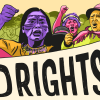Sept. 21, 2016
Amidst the vast hunting estates, high-walled castles and luxury golf courses that characterize much of the Scottish Highlands a surprising development is taking place – local communities are recovering land. In the past 20 years some 25,000 people have begun to collectively manage 500,000 acres of land in a region renowned for the most unequal land distribution in the Global North. In Scotland 50% of the land is owned privately by 432 individuals and not only this, but just 16 individuals own 10% of Scottish land. One of them is the Duke of Buccleuch who, with 240,000 acres of land, is the largest landowner not only in Scotland but in the whole of the UK.[1]
“This is about building sustainable communities and futures in a region where, up until very recently, young people were left with no choice but to migrate in search of opportunities elsewhere,” says Peter Peacock of Community Land Scotland at a conference held in Inverness on 09 September on “Changing the Rules of Land Ownership.”
Community Land Scotland, a participant in the Global Call to Action on Indigenous and community Land Rights, is currently working with community land owners and a team of researchers from the Centre for Scotland’s Land Futures to discuss a set of criteria they will use to begin to document the benefits of community managed land. These criteria focus on the ways that community managed land can contribute positively in areas from economic, financial and infrastructure development to social, cultural and heritage, environment and democratic governance.
Founded in 2010, Community Land Scotland represents the Scottish community landowning movement and has played a key role in promoting changes to legislation as well as empowering communities to begin the process of collective land ownership.
The process of Community Managed land dates back to the 1990s when a group of crofters – tenants who occupy and work on a landholding – worked together to raise the money to buy the bankrupt North Lochinver Estate. The crofters negotiated a land buyout agreement to win back the land of their forefathers, a process that inspired others and began a broad community land movement which in turn influenced subsequent land reform processes in Scotland. When the Scottish Government began the process of Land Reform, the focus was on security of tenure of communities as opposed to individuals. The land reform acts include:
-The Land Reform Act 2003, which focuses on the public right of access to land and inland water for recreational and other purposes, and for crossing land. Also, it allows crofting communities the right to buy the land with which those communities have a connection. This right can be exercised at any time, even if the land is not for sale [2].
-And the most recent Act in March 2016 which focuses on sale of land stipulating that when a piece of land comes up for sale, the community is given first priority. And in a case where an owner doesn’t want to sell and the community can justify that it should own the land to achieve sustainable development, the owner can be forced to sell [3].
And with this, the Government has also set a target –the same as that of the Global Call to Action on Indigenous and community Land Rights – of aiming to double the amount of land owned by communities from 500,000 to 1 million acres by 2020.
The criteria being developed by Community Land Scotland and the Centre for Scotlands Land Futures will play a fundamental role in documenting the benefits of community managed land as well as inspiring other communities to organize and do the same.
“Having our own land has given hope for the future that the local community will be something more than a holiday home resort in 20 years time. For the first time the community is shaping its own future,” said a member of West Harris Trust which formed when crofting townships were purchased by the community from the Scottish Government in 2010. The community is using land ownership to drive positive and sustainable change – creating sustainable energy, revitalizing the community by attracting new residents and by conserving and increasing understanding of their natural and cultural heritage[4].
Learn more about community managed land on the Isle of Eigg, the second largest of the Scottish Small Isles here:
Photo Credit: © ILC/Jason Taylor
[1]http://www.heraldscotland.com/news/environment/14537104.Wealthy_Scots_aristo_accused_of_endangering_public_health/and https://www.sundaypost.com/news/scottish-news/aristocrats-tycoons-and-billionaires-the-people-who-really-own-scotland-2/
[2] http://www.gov.scot/Topics/Environment/Countryside…


